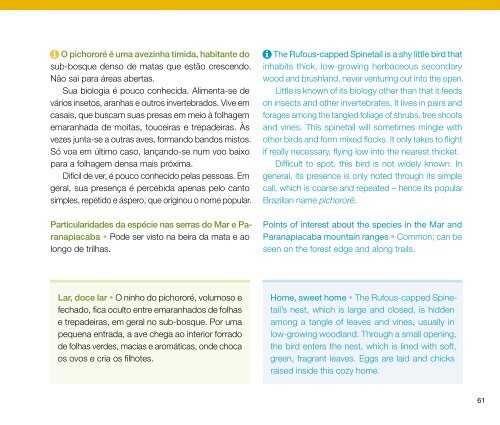Guia de aves Mata Atlântica Paulista - Secretaria do Meio Ambiente
Guia de aves Mata Atlântica Paulista - Secretaria do Meio Ambiente
Guia de aves Mata Atlântica Paulista - Secretaria do Meio Ambiente
Create successful ePaper yourself
Turn your PDF publications into a flip-book with our unique Google optimized e-Paper software.
O pichororé é uma avezinha tímida, habitante <strong>do</strong><br />
sub-bosque <strong>de</strong>nso <strong>de</strong> matas que estão crescen<strong>do</strong>.<br />
Não sai para áreas abertas.<br />
Sua biologia é pouco conhecida. Alimenta-se <strong>de</strong><br />
vários insetos, aranhas e outros invertebra<strong>do</strong>s. Vive em<br />
casais, que buscam suas presas em meio à folhagem<br />
emaranhada <strong>de</strong> moitas, touceiras e trepa<strong>de</strong>iras. Às<br />
vezes junta-se a outras <strong>aves</strong>, forman<strong>do</strong> ban<strong>do</strong>s mistos.<br />
Só voa em último caso, lançan<strong>do</strong>-se num voo baixo<br />
para a folhagem <strong>de</strong>nsa mais próxima.<br />
Difícil <strong>de</strong> ver, é pouco conheci<strong>do</strong> pelas pessoas. Em<br />
geral, sua presença é percebida apenas pelo canto<br />
simples, repeti<strong>do</strong> e áspero, que originou o nome popular.<br />
Particularida<strong>de</strong>s da espécie nas serras <strong>do</strong> Mar e Pa -<br />
ranapiacaba • Po<strong>de</strong> ser visto na beira da mata e ao<br />
longo <strong>de</strong> trilhas.<br />
The Rufous-capped Spinetail is a shy little bird that<br />
inhabits thick, low-growing herbaceous secondary<br />
wood and brushland, never venturing out into the open.<br />
Little is known of its biology other than that it feeds<br />
on insects and other invertebrates. It lives in pairs and<br />
forages among the tangled foliage of shrubs, tree shoots<br />
and vines. This spinetail will sometimes mingle with<br />
other birds and form mixed flocks. It only takes to flight<br />
if really necessary, flying low into the nearest thicket.<br />
Difficult to spot, this bird is not wi<strong>de</strong>ly known. In<br />
general, its presence is only noted through its simple<br />
call, which is coarse and repeated – hence its popular<br />
Brazilian name pichororé.<br />
Points of interest about the species in the Mar and<br />
Pa ranapiacaba mountain ranges • common; can be<br />
seen on the forest edge and along trails.<br />
Lar, <strong>do</strong>ce lar • O ninho <strong>do</strong> pichororé, volumoso e<br />
fecha<strong>do</strong>, fica oculto entre emaranha<strong>do</strong>s <strong>de</strong> folhas<br />
e trepa<strong>de</strong>iras, em geral no sub-bosque. Por uma<br />
pequena entrada, a ave chega ao interior forra<strong>do</strong><br />
<strong>de</strong> folhas ver<strong>de</strong>s, macias e aromáticas, on<strong>de</strong> choca<br />
os ovos e cria os filhotes.<br />
Home, sweet home • The Rufous-capped Spinetail’s<br />
nest, which is large and closed, is hid<strong>de</strong>n<br />
among a tangle of le<strong>aves</strong> and vines, usually in<br />
low-growing woodland. Through a small opening,<br />
the bird enters the nest, which is lined with soft,<br />
green, fragrant le<strong>aves</strong>. Eggs are laid and chicks<br />
raised insi<strong>de</strong> this cozy home.<br />
61

















